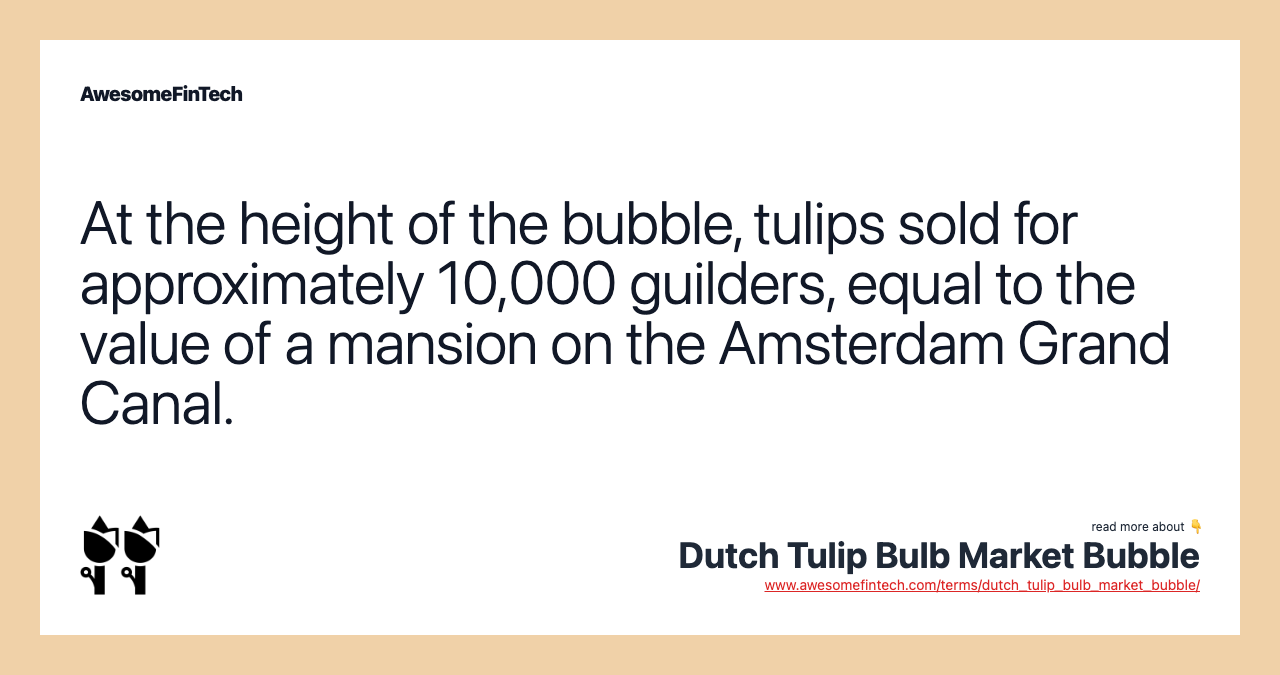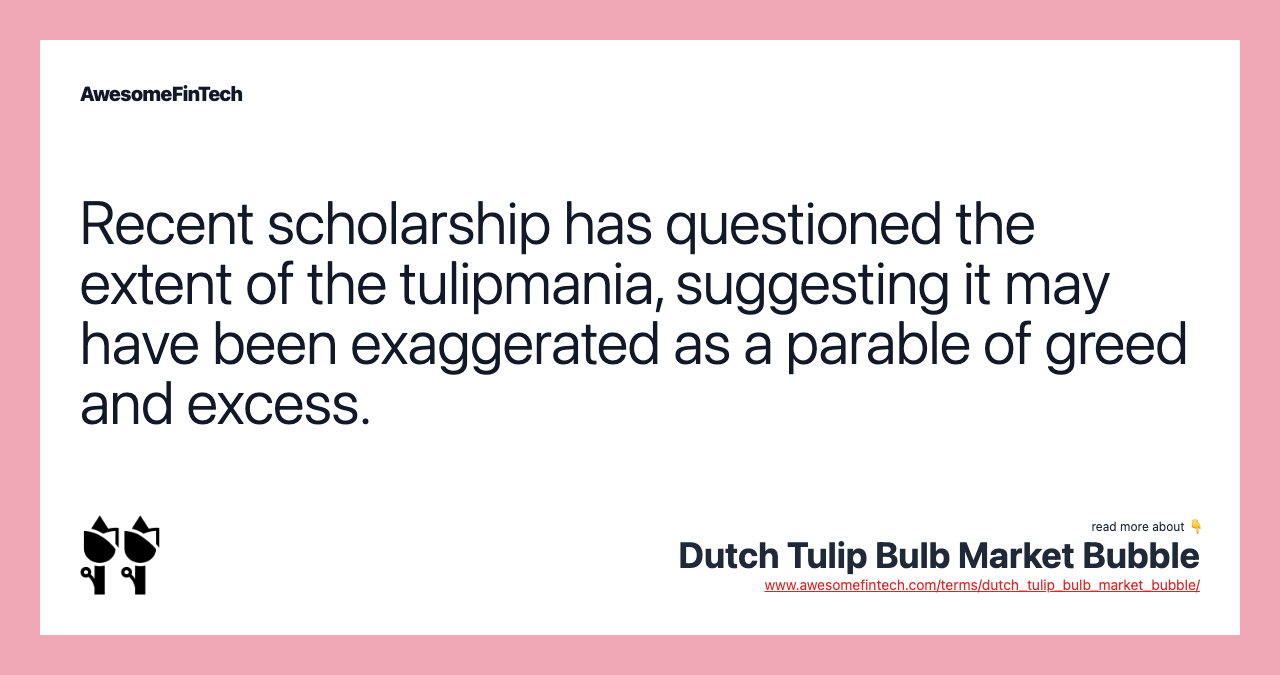Dutch Tulip Bulb Market Bubble
The Dutch tulip bulb market bubble, also known as 'tulipmania' was one of the most famous market bubbles and crashes of all time. Earl Thompson, an economist, has actually determined that because of this sort of production lag and the fact that growers entered into legal contracts to sell their tulips at a later date (similar to futures contracts), which were rigorously enforced by the Dutch government, prices rose for the simple fact that suppliers couldn't satisfy all of the demand. The Dutch tulip bulb market bubble, also known as 'tulipmania' was one of the most famous market bubbles and crashes of all time. Dutch speculators spent incredible amounts of money on these bulbs, but they only produced flowers for a week — many companies formed with the sole purpose of trading tulips. A large part of this rapid decline was driven by the fact that people had purchased bulbs on credit, hoping to repay their loans when they sold their bulbs for a profit.

More in Economy
What Was the Dutch Tulip Bulb Market Bubble?
The Dutch tulip bulb market bubble, also known as 'tulipmania' was one of the most famous market bubbles and crashes of all time. It occurred in Holland during the early to mid-1600s when speculation drove the value of tulip bulbs to extremes. At the height of the market, the rarest tulip bulbs traded for as much as six times the average person's annual salary.
Today, the tulipmania serves as a parable for the pitfalls that excessive greed and speculation can lead to.




History of the Dutch Tulip Bulb Market’s Bubble
Tulips first appeared in Europe in the 16th century, arriving via the spice trading routes that lent a sense of exoticism to these imported flowers that looked like no other flower native to the continent. It is no surprise then that tulips became a luxury item destined for the gardens of the affluent: according to The Library of Economics and Liberty, "it was deemed a proof of bad taste in any man of fortune to be without a collection of [tulips]."
Following the affluent, the merchant middle classes of Dutch society (which did not exist in such developed form elsewhere in Europe at the time) sought to emulate their wealthier neighbors and, too, demanded tulips. Initially, it was a status item that was purchased for the very reason that it was expensive.
But at the same time, tulips were known to be notoriously fragile, and would readily die without careful cultivation. In the early 1600s, professional cultivators of tulips began to refine techniques to grow and produce the flowers locally, establishing a flourishing business sector, that has persisted to this day.
According to Smithsonian Magazine, the Dutch learned that tulips could grow from seeds or buds that grew on the mother bulb. A bulb that grew from seed would take seven to 12 years before flowering, but a bulb itself could flower the very next year. So-called "broken bulbs" were a type of tulip with a striped, multicolored pattern rather than a single solid color that evolved from a mosaic virus strain. This variation was a catalyst causing a growing demand for rare, “broken bulb” tulips which is what ultimately led to the high market price.
In 1634, tulipmania swept through Holland. The Library of Economics and Liberty writes, "The rage among the Dutch to possess [tulip bulbs] was so great that the ordinary industry of the country was neglected, and the population, even to its lowest dregs, embarked in the tulip trade."
A single bulb could be worth as much as 4,000 or even 5,500 florins_ — _since the 1630s florins were gold coins of uncertain weight and quality it is hard to make an accurate estimation of today's value in dollars, but Mackay does give us some points of reference: among other things, 4 tuns of beer cost 32 florins. That's around 1,008 gallons of beer, or 65 kegs of beer. A keg of Coors Light costs around $90, and so 4 tuns of beer ≈ $4,850 and 1 florin ≈ $150. That means that the best of tulips cost upwards of $750,000 in today's money (but with many bulbs trading in the $50,000 - $150,000 range). By 1636, the demand for the tulip trade was so large that regular marts for their sale were established on the Stock Exchange of Amsterdam, in Rotterdam, Haarlem, and other towns.
It was at that time that professional traders ("stock jobbers") got in on the action, and everybody appeared to be making money simply by possessing some of these rare bulbs. Indeed, it seemed at the time that the price could only go up; that "the passion for tulips would last forever." People began buying tulips with leverage, using margined derivatives contracts to buy more than they could afford. But as quickly as it began, confidence was dashed. By the end of the year 1637, prices began to fall and never looked back.
A large part of this rapid decline was driven by the fact that people had purchased bulbs on credit, hoping to repay their loans when they sold their bulbs for a profit. But once prices started their decline, holders were forced to liquidate — to sell their bulbs at any price and to declare bankruptcy in the process. Smithsonian Magazine indeed notes that "[h]undreds who, a few months previously had begun to doubt that there was such a thing as poverty in the land suddenly found themselves the possessors of a few bulbs, which nobody would buy," even at prices one-fourth of what they paid. By 1638, tulip bulb prices had returned to from whence they came.
The Bubble Bursts
By the end of 1637, the bubble had burst. Buyers announced they could not pay the high price previously agreed upon for bulbs and the market fell apart. While it was not a devastating occurrence for the nation's economy, it did undermine social expectations. The event destroyed relationships built on trust and people's willingness and ability to pay.
According to Smithsonian, Dutch Calvinists painted an exaggerated scene of economic ruin because they worried that the tulip-driven consumerism boom would lead to societal decay. They insisted that such great wealth was ungodly and the belief remains to this day.
Real-World Examples of Extreme Buying
The obsession with tulips — referred to as "Tulipmania" — has captured the public's imagination for generations and has been the subject of several books including a novel called Tulip Fever by Deborah Moggach. According to popular legend, the tulip craze took hold of all levels of Dutch society in the 1630s. A Scottish journalist Charles Mackay, in his famous 1841 book Memoirs of Extraordinary Popular Delusions and the Madness of Crowds, wrote that "the wealthiest merchants to the poorest chimney sweeps jumped into the tulip fray, buying bulbs at high prices and selling them for even more."
Dutch speculators spent incredible amounts of money on these bulbs, but they only produced flowers for a week — many companies formed with the sole purpose of trading tulips. However, the trade reached its fever pitch in the late 1630s.
In the 1600s the Dutch currency was the guilder, which preceded the use of the euro. At the height of the bubble, tulips sold for approximately 10,000 guilders. In the 1630s a price of 10,000 guilders equated roughly the value of a mansion on the Amsterdam Grand Canal.
Did the Dutch Tuliplmania Really Exist?
In the year 1841, the author Charles Mackay published his classic analysis, Extraordinary Popular Delusions and the Madness of Crowds. Among other phenomena, Mackay (who never lived in or visited Holland) documents asset price bubbles — the Mississippi Scheme, the South Sea Bubble, and the tulipmania of the 1600s. It is through Mackay's short chapter on the subject that it became popularized as the paradigm for an asset bubble.
Mackay makes the point that sought-after bulbs of particular rarity and beauty did sell for six figures in today's dollars, but there is actually little evidence that the mania was as widespread as has been reported. The political economist Peter Garber in the 1980s published an academic article on the Tulipmania. First, he notes that tulips are not alone in their meteoric rise: "a small quantity of ... lily bulbs recently was sold for 1 million guilders ($480,000 at 1987 exchange rates)," demonstrating that even in the modern world, flowers can command extremely high prices.
Additionally, because of the timing in tulip cultivation, there was always a few years of lag between demand pressures and supply. Under normal conditions, this wasn't an issue since future consumption was contracted for a year or more in advance. Because the 1630's rise in prices occurred so rapidly and after bulbs were already planted for the year, growers would not have had an opportunity to increase production in response to price.
Earl Thompson, an economist, has actually determined that because of this sort of production lag and the fact that growers entered into legal contracts to sell their tulips at a later date (similar to futures contracts), which were rigorously enforced by the Dutch government, prices rose for the simple fact that suppliers couldn't satisfy all of the demand. Indeed, actual sales of new tulip bulbs remained at ordinary levels throughout the period. Thus, Thompson concluded that the "mania" was a rational response to demands embedded in contractual obligations.
Using data about the specific payoffs present in the contracts, Thompson argued that "tulip bulb contract prices hewed closely to what a rational economic model would dictate...Tulip contract prices before, during, and after the 'tulipmania' appear to provide a remarkable illustration of 'market efficiency." Indeed, by 1638, tulip production had risen to match the earlier demand, which had by then already waned, creating an over-supply in the market, further depressing prices.
The historian Anne Goldgar has also written on the Tulip mania, and agrees with Thompson, casting doubt on its "bubbleness." Goldgar argues that although tulip mania may not have constituted an economic or speculative bubble, it was nonetheless traumatic to the Dutch for other reasons. "Even though the financial crisis affected very few, the shock of tulipmania was considerable."
In fact, Goldgar goes on to argue that the "Tulip Bubble" was not at all a mania (although a few people did pay very high prices for a few very rare bulbs, and a few people did lose a lot of money as well). Instead, the story has been incorporated into the public discourse as a moral lesson, that greed is bad and chasing prices can be dangerous. It has become a fable about morality and markets, invoked as a reminder that what goes up must go down. Moreover, the Church latched on to this tale as a warning against the sins of greed and avarice; it became not only a cultural parable, but also a religious apologue.
Related terms:
Amsterdam Stock Exchange (AEX) .AS definition
Founded in the 1600s with the Dutch East India Co. the Amsterdam Stock Exchange is considered the oldest in the world. It merged to form Euronext Amsterdam in 2000. read more
Bubble
A bubble is an economic cycle that is characterized by a rapid economic expansion followed by a contraction. read more
Economics : Overview, Types, & Indicators
Economics is a branch of social science focused on the production, distribution, and consumption of goods and services. read more
Housing Bubble
A housing bubble is a run-up in home prices fueled by demand, speculation, and exuberance, which bursts when demand falls while supply increases. read more
Inflation
Inflation is a decrease in the purchasing power of money, reflected in a general increase in the prices of goods and services in an economy. read more
Jobber
Jobber -- also called a "stockjobber" -- is a slang term for a market maker on the London Stock Exchange prior to October 1986. read more
Ponzi Mania
Ponzi mania was the investor sentiment Bernie Madoff's 2008 Ponzi scheme, when everyone raced to question the credibility of their money manager. read more
Ponzimonium
A ponzimonium is an outbreak of fraudulent Ponzi schemes that challenge authorities and may not be discovered until many months or years have passed. read more
Short Selling : What Is Shorting Stocks?
Short selling occurs when an investor borrows a security, sells it on the open market, and expects to buy it back later for less money. read more
Tulipmania
Tulipmania is the story of the first ever financial bubble, which took place in the 17th century. read more